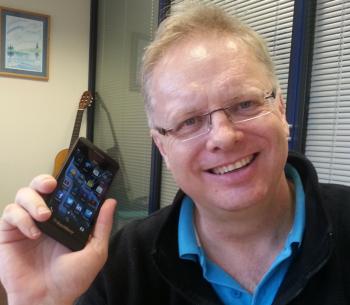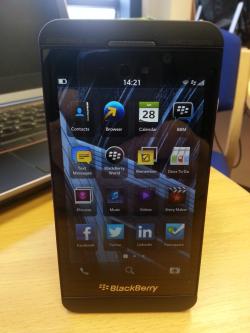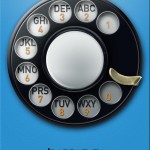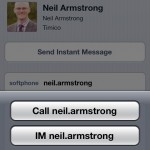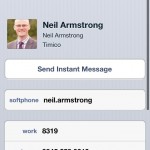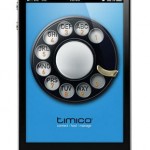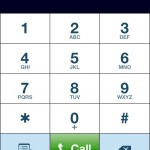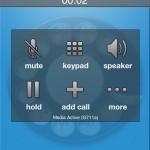I started to look at mobile VoIP clients a good 8 or 9 years ago. At the time the handsets were near enough useless – battery life was rubbish and the processors lacked the oomph to properly run a SIP user agent.
The advent of the modern day smart phone has changed all this, together with years of development effort put in to improve the soft clients themselves.
Now, most of us have a VoIP client on our phone – almost certainly Skype, maybe 3CX, Bria or Eyebeam. I stopped counting the number of low cost VoIP calling services that you might use as the target for the mobile VoIP client.
Many desktop VoIP clients are not supported on mobile. So if you use MSN or Facebook or Google+ or Lync even their mobile clients almost certainly do not support voice but are just used for presence and Instant Messaging.
The dwindling list of vendors of Unified Comms equipment offer their own mobile VoIP clients, which necessarily have better functionality than those I’ve just mentioned from the major platforms. Ask Avaya or Mitel about it and they will proudly show off their solution. These vendor specific solutions usually use a third party soft client tailored to their specific need. Bria from Counterpath is one and MobileMax is another.
I am very proud to announce that Timico has introduced its own mobile VoIP client . There are some clear differentiators from the generic soft phones mentioned earlier and used with hosted solutions.
First of all the user’s account is tied to the employer’s VoIP subscription, so the desktop extension and DDI is the same as the mobile. The user interface is also similar to that of the soft client running on the desktop and is controlled using the same familiar portal. Mobile users can not only speak and do video calls with other users of the network, but are able the see the availability of others
There is more to the technology that goes in to making a successful mobile VoIP client than is at first apparent. A little technology primer might serve a useful purpose here. When you speak into a telephone you are using an analogue broadcast service, i.e. your voice. In order to get to the telephone at the far end this analogue signal is converted into data packets (i.e. digitised) and then transmitted using computer networking technology, in our case Internet Protocol and the layers of networking technologies that come under its umbrella.
The sent packets have to traverse a number of hurdles in the guise of different networks and routers before arriving at their intended destination (next door, Australia – anywhere connected to the internet). Voice is very time sensitive. You really notice the difference if there is a delay between the person at the other end speaking and you hearing it, and vice versa. Slow or poor quality hops in the network can affect the quality of the user experience.
Use of mobile networks for VoIP transmission comes with its own specific issues. 3G is a notoriously latency ridden data service and a number of mobile operators actually block VoIP services (although they are far from transparent in their approach to this). It is too early to assess the practical usability of 4G because there is only one service provider in the market and that network will be only lightly used. The issue of cost of bandwidth over a mobile carrier network has also historically made VoIP impracticable in many cases.
WiFi is the sensible alternative. Although even WiFi comes with its own issues with Ethernet style best efforts transmission. Packets that collide with other packets don’t arrive at their destination. The busier the local WiFi network, the more likely you are to suffer from poor quality voice.
In practical terms this is likely to mean if you are sitting in an office with many hot desks where WiFi is the principal means of connecting to corporate resources, then that network is likely to become congested. This congestion may not be particularly noticeable to laptop users just doing emails or general web use.
A congested WiFi network that is ok for most uses might not be good for VoIP. In an office environment this can be engineered around, by creating more cells/hotspots each with fewer users. At home there is far less likely to be a problem although VoIP packets in this scenario are more likely to be using the open internet for transmission.
A VoIP phone is actually a computer that looks like a phone. Fortunately the lost packet compensation and packet processing techniques used in modern mobile VoIP clients (smart phones/computers) are able to overcome many “noisy” environmental scenarios, or at least go a long way towards mitigating their effects.
Timico’s announcement today comes after some time working with partners (Genband) to develop the soft-client. The app is available on the Apple App Store to existing (and new!) Timico VoIP customers and is a piece of cake to install – use of our Mobile Endpoint Provisioning (MEP) portal means all the user has to do is enter a username and password and they are up and running.
The MEP is worth further mention. With the MEP comes the ability to change mobile client settings on-the-fly which provides the Timico operations team with a critical tool for managing your mobile VoIP solution in near real time. There are over 200+ settings that the MEP controls, including default codec selection, NAT traversal settings and the keep-alive timer value.
There are often deployments where we might initially need to make adjustments to these settings to suit the environment in which you use the service. We can do this transparently and without requiring interaction with the end-users.
Another feature to our service that is designed to provide the optimum user experience is our Client QOS notification. The mobile client analyses the RTCP statistics in real time. Should these stats fall below predefined thresholds then the user will receive a notification informing them of ‘network quality issues’.
I’ve been around polling some of the early users and got the following comments:
- “I’ve ditched my deskphone and now just use the iPhone app”
- “Connects very quickly”
- “I was sat in Starbucks in Canada and used it to call the office”
I’m sure that I will have previously mentioned that last year we won the ITSPA Award for the best Enterprise Unified Comms service. This mobile client adds nicely to that existing feature-rich service set. It’s going to be a terrific tool for people who need to make calls out of the office but don’t want to pay extortionate roaming charges or use their own phones.
Because the VoIP service is tied to their company’s business account then all calls just appear on the standard monthly bill. Calls to other internal VoIP users are of course free.
So there we have it. The mobile VoIP client has finally come into the world of reliable, serious business strength communications. If you want to try the service check it out here . Press release yurr1.
1 note South Walian accent
